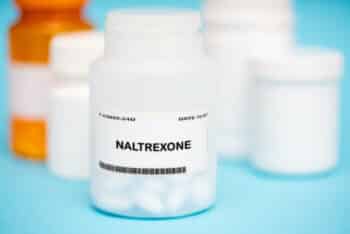Naltrexone

What Is Naltrexone?
Naltrexone is a medication that is FDA-approved to treat Opioid use disorders. Unlike some other treatments for Opioid addiction, Naltrexone is non-addictive and does not lead to physical dependence. Other benefits include its ability to effectively reduce cravings for substances, prevent the euphoric effects of Opioids if consumed, and support long-term recovery by decreasing relapse rates.
Naltrexone has been shown to be an effective tool in the broader strategy of addiction recovery, especially when combined with counseling and other supportive measures.
How Naltrexone Works
Naltrexone is an Opioid antagonist, which means it operates by binding to and blocking the Opioid receptors in the brain. When these receptors are activated by Opioids, they trigger a cascade of neurological and physiological responses, including pain relief, euphoria, and sedation. Naltrexone competes with these Opioids for the same receptor sites. When it binds to these receptors, it effectively blocks them, preventing the Opioids from exerting their typical effects.
By blocking the euphoric effects of Opioids, Naltrexone makes the act of using less appealing. If someone on Naltrexone tries to use an Opioid, they will not experience the anticipated high, which can serve as a deterrent against future drug use. This characteristic is particularly beneficial in preventing relapse, especially in the early stages of recovery when the risk is highest.
Over time, the regular use of Opioids can rewire the brain’s reward system, leading to increased cravings. Naltrexone can help reduce these cravings by dulling the rewarding sensations usually associated with Opioid use. With the pleasure or high of the drug diminished, the psychological drive to use the drug can decrease.
It’s vital to understand that while Naltrexone can be a powerful tool in managing Opioid use disorders, it is most effective when combined with other treatment modalities, including counseling, behavioral therapies, and supportive care.
How Is Naltrexone Administered?
Naltrexone can be given in two main forms:
- Oral tablet: This pill form is typically prescribed to be taken once a day. Adherence is critical for the medication to be effective, so it requires a commitment from the patient to take it regularly.
- Extended-release injection: Administered once a month, this injectable form of Naltrexone (often known by its brand name, Vivitrol) can be advantageous for those who might have difficulty remembering a daily pill. The injection needs to be given by a healthcare professional.
Side-Effects Of Naltrexone
Naltrexone, like all medications, can have side effects. These side effects can vary among individuals, and while some people might experience them, others may not. Below is an expanded list of the potential side effects:
- Digestive issues: These can include nausea, vomiting, diarrhea, abdominal pain, or decreased appetite.
- Mental and emotional changes: Feelings of nervousness, anxiety, or irritability can occur.
- Physical discomfort: This can manifest as headaches, muscle or joint pain, or fatigue.
- Sleep disturbances: Naltrexone might cause trouble sleeping or lead to vivid or unusual dreams. Some people might experience drowsiness, while others could have insomnia.
- Dizziness or fainting: Especially when getting up too quickly from a sitting or lying position.
- Severe depression or suicidal thoughts: If feelings of severe depression or suicidal thoughts emerge, seek medical attention immediately.
Risk Of Heroin Overdose
A critical safety concern related to Naltrexone is the increased risk of a potential Heroin overdose. Individuals treated with Naltrexone may have a reduced tolerance to Opioids:
- Reduced Tolerance: If a person stops taking Naltrexone and uses Heroin or another Opioid, they may be at a higher risk of overdose because their body’s tolerance to the effects of Opioids might have decreased while on Naltrexone.
- Bypassing Blockade: There is also a risk that individuals might attempt to override the Opioid-blocking effect of Naltrexone by using large amounts of Heroin or other Opioids. Doing so can lead to serious injury, coma, or death due to an overdose.
It’s crucial to note that while these side effects are possible, not everyone will experience them. Always discuss any concerns about side effects with a healthcare professional. If someone using Naltrexone thinks they have accidentally taken Fentanyl or any other Opioid, they should seek emergency medical attention immediately.
Seeking Treatment For An Opioid Addiction
Overcoming Opioid addiction can be challenging, but it is possible. Medications like Naltrexone can play a vital role in this journey, offering a medically-assisted approach to reducing cravings and preventing relapse. Remember, the combination of medication with counseling and behavioral therapies is the most effective way to treat addiction. By seeking treatment, individuals are giving themselves the best chance at a life free from the shackles of Opioid dependence.
The road to recovery starts with taking that first step. Reach out to a treatment provider today and learn how they can help you on your journey to a brighter, healthier future.